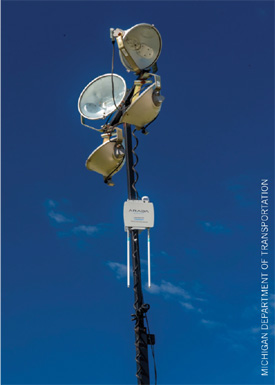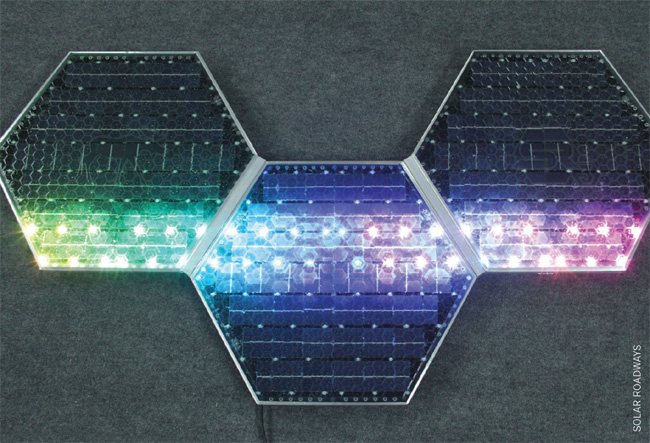November/December 2016
Roads 2.0
BY EVA KAPLAN-LEISERSON
 Autonomous vehicles are a hot topic these days. Even President Obama has weighed in, with a bylined op-ed in the Pittsburgh Post-Gazette in September lauding the release of new federal guidelines and the promise of the technology to save lives. NSPE is a leading voice as well, advocating for safety in the development, testing, and deployment of AVs and the involvement of licensed professional engineers (see NSPE Urges Additional Safety Protections in Federal Autonomous Vehicle Guidelines).
Autonomous vehicles are a hot topic these days. Even President Obama has weighed in, with a bylined op-ed in the Pittsburgh Post-Gazette in September lauding the release of new federal guidelines and the promise of the technology to save lives. NSPE is a leading voice as well, advocating for safety in the development, testing, and deployment of AVs and the involvement of licensed professional engineers (see NSPE Urges Additional Safety Protections in Federal Autonomous Vehicle Guidelines).
But the way transportation will look in decades to come rests on more than just vehicles. In fact, the vehicles literally rest on another element: roads and highways. Although this infrastructure has not changed substantially in decades, evolution is underway—both to adapt to autonomous and connected vehicles and due to new innovations, for example in materials.
A wide variety of stakeholders are helping to make this happen, including the federal government, academic institutions, automakers, and technology companies. And, of course, state DOTs, with some out in front showing us how the road will meet the rubber.
What will Roads 2.0 look like? It’s early to make definitive statements, but a sampling of efforts can provide a glimpse.
 THIS DEDICATED SHORT-RANGE COMMUNICATIONS TRANSMITTER BROADCASTS AND RECEIVES INFORMATION BETWEEN INFRASTRUCTURE AND VEHICLES.
THIS DEDICATED SHORT-RANGE COMMUNICATIONS TRANSMITTER BROADCASTS AND RECEIVES INFORMATION BETWEEN INFRASTRUCTURE AND VEHICLES.Stuck in Time
First, it’s worth examining why roads and highways haven’t changed substantially, while vehicle technology has.
Chris Luebkeman is director of the Global Foresight, Research, and Innovation groups at Arup, an international engineering and consulting firm. He was also coauthor of the company’s Future of Highways report, released in 2014.
Luebkeman says various factors have held infrastructure evolution back, such as the multiple levels of investment (federal, state, county, city) required and the need for staff who are “willing, able, and educated” in areas such as materials technology.
But our highways are overloaded and tired, he says, and they need the care and attention that we would give any of our elders.
The Arup report points to growing challenges for infrastructure, such as changing weather patterns, population growth, capacity constraints, and land and capital shortages.
Innovation that can help address some of these issues, according to Arup, includes connected infrastructure, vehicle-to-vehicle communication, smart logistics, and new materials. For example, the report says, wireless networks of ultra-low-power sensors will allow monitoring of bridges and tunnels. Multimodal options might incorporate smart ticketing systems, real-time travel planners, and car and bike sharing services. And roadways could include solar capacity for power generation and embedded wireless charging for electric vehicles.
Some of those innovations are already being investigated, and even tested, by state departments of transportation.
Michigan
The Michigan Department of Transportation has been investing in intelligent transportation systems for a couple of decades, explains ITS Program Administrator Matt Smith, P.E. The department sees technology as a way to drive down the number of traffic fatalities, which has flatlined in the state despite investments in traditional engineering fixes. Smith stresses that any technology MDOT pursues or applies is in support of the department’s primary goal: “safe and efficient travel on our roads by both people and freight.”
The location of the auto industry in the state enables collaboration with researchers and developers. The industry “wants to test some of the technology on roadways…[and] we want to do what we can on the infrastructure side to help that out,” Smith says.
Connected vehicles is one major area that the state has been working on for about the last decade with industry and the US Department of Transportation. The technology is still mostly in the prototype and initial deployment stages, but Smith believes this is the future of transportation—“relying not just on being a very smart car filled with a lot of technology, but a smart car filled with technology also communicating with other cars and intelligent infrastructure.”
For example, under development are applications related to red light violation warning, with traffic signals broadcasting information to alert drivers that they could run the light at their current speed. In the future, that might mean automated emergency braking, Smith says.
Another example relates to what he calls “road weather,” with snow and ice a prevalent issue in Michigan much of the year. Roadside environmental sensor stations combined with equipment on board vehicles, and cellular and dedicated short-range communications (DSRC) to tie them together, can broadcast information to vehicles—for instance about locations of black ice. Vehicles can also pick up the information and broadcast it back to traffic operations and maintenance staff.
In addition, Smith explains that MDOT is outfitting its own vehicles with sensors to get real-time profiles of pavement conditions as the vehicles travel in their normal course of business. “That has the potential to save us millions of dollars in pavement surveys,” he says, “by just having that happen as people go through point A to point B.”
The various applications will be undergoing on-road prototype deployment either this fall or early spring. This builds on auto manufacturers’ initial concept and test track work with the US DOT.
Collaborating directly with these companies is a different approach for the department, says Smith. MDOT has to rely on auto and technology companies “to get it right, just like they have to rely on us to get it right.”
Although everyone has the same customer, Smith says, it’s taking some work for the different groups to figure out how to work with each other. “That’s been a new and enlightening experience.”
Missouri
Road to Tomorrow is Missouri’s initiative combining 21st-century transportation technology with creation of new revenue streams. Tom Blair, P.E., leads the effort at the state department of transportation.
Missouri has not increased transportation investment with traditional taxing and fee methods for more than 25 years, Blair explains. The state’s highway commission recognized both the funding need and that, as disruptive innovations arrive, they may provide opportunities to create new business models.
“If we’re unsuccessful,” Blair says, “we will have autonomous vehicles on dumb or underfunded roadways.”
MoDOT believes that states can create win-win scenarios by working with private industry. The department assembled a multidisciplinary team to do so.
Since June 2015, it has received more than 350 project idea submissions, which have been categorized into several major areas, such as creation of energy on the public right of way.
MoDOT has contracted with Idaho-based Solar Roadways to test their modular, intelligent panels. The department is installing the technology at the Route 66 welcome center, in order to examine its performance and durability. Ultimately, the panels could not only generate energy for highway lights and traffic signals but also provide a revenue stream through partnership with utility companies.
In addition, the panels could reduce expenses, Blair notes. Their LED lights would take the place of roadway striping, cutting maintenance costs. And the built-in heating elements would eliminate the need to dispatch trucks with salt. “These are all things that add up to real dollars” if they’re proven to work, he says. “They don’t just make me feel good.”
Another area of focus is the Internet of Things, connecting devices and vehicles using electronic sensors with the goal of smart traffic control and road assistance. That’s closely tied with another area, smart pavement, which could provide digital, communication, and information services to MoDOT, commercial fleet operators, and private drivers.
In June, MoDOT put out a request for proposal offering up assets from land to bridges to camera poles. The department is now negotiating with a consortium of companies that has proposed using a four-mile stretch of the interstate to establish a tech integration lab, which they’ll open up to vendors to test hardware and software.
This could eventually allow the interstate highway to become a platform for technology and data services, says Blair, just as a smartphone is more than just a phone but also a platform for many different apps and services. In the future, the highway could enable marketable services such as wireless charging for electric vehicles.
The project will also enable the DOT to learn what future contracts should include when rebuilding highways such as Interstate 70, the oldest in the country. “Do we really want to build back the same road with more capacity,” Blair asks, “or should we be looking at innovations and partnerships to build a smarter, 21st-century roadway?”
Colorado
RoadX is the Colorado Department of Transportation’s proactive approach to the future of transportation, explains the program’s director, Peter Kozinski, P.E. Although historically DOTs have waited for trends to fully mature before they react, he says, CDOT is taking a different approach—treating the program like a startup within the DOT and actively pursuing partnerships to get technology out faster and reap safety and mobility benefits.
Started about a year ago, the new department is dramatically less risk adverse, Kozinski says, interested in pushing boundaries in areas such as urban mobility and rural safety.
For example, CDOT is partnering with a mapping and real-time transportation data company to deliver a vehicle-to-infrastructure project over a cellular network. It will enable connected cars with sensor technology to pick up traffic incidents and road conditions, then send the information to a cloud that analyzes, verifies, and validates the data and distributes it to nearby vehicles and a traffic management center.
This will provide hyperaccurate information in real time, says Kozinski, enabling much more detailed information than in current GPS applications. A major benefit: helping to prevent crashes that occur when traffic suddenly comes to a stop.
Another project CDOT is considering involves embedded technology in pavement, which could be used, for example, in a rural area known for run-off-road crashes. In the future, the RoadX director says, the pavement could notify emergency vehicles or department maintenance staff if a vehicle left the roadway at a speed and trajectory indicating unsafe conditions.
Kozinski also emphasizes that safety is paramount in all these innovations. New partners such as technology companies, data service providers, and security experts can provide their tools, skills, and business models to the DOT to help with that end goal, he explains. “We are eager to deploy these technologies and prove their validity.”
And what can work in Colorado, given its unique geography and weather conditions, can work in the 49 other states, he says. “We want to raise the waters of awareness about this technology and what it can bring so everybody can be lifted up.”
Learn more
Keeping Up
Innovation can feel overwhelming. But Kozinski advises not doing too much too quickly. Get support of management and provide resources to a few champions who really believe in the efforts, he says. “If it’s just another duty for someone else to carry on with other standard affairs, they’re not going to be able to dedicate interest.”
You don’t need a whole lot of money to be successful, he says—rather, what’s important is a change in philosophy. “Being more willing to say yes than no, you can find great partners out there who want to help you.”
Collaboration is a strategy Arup’s Luebkeman points to as well. He finds the “potential for integrated thinking” exciting. “When we’re looking at the future of highways, we have to have our highway departments working closely with our departments of parks and recreation, our rail systems, our metro systems, and trucking. We cannot continue to work in isolation.”
Multimodality is becoming increasingly important, he emphasizes, especially as the younger generations feel less impetus to purchase their own vehicles.
Smith says technology investments should be viewed not as the need to put money into shiny objects, but as driven by the same goals as the traditional construction and maintenance of infrastructure: getting people safely from point A to point B.
He suggests accessing resources through organizations such as the American Association of State Highway Transportation Officials, the Institute of Transportation Engineers, the Intelligent Transportation Society of America, and the US Department of Transportation.
Big change is coming quickly, he says. “We definitely have to be ready for it.”

THE MISSOURI DOT WILL TEST SOLAR ROADWAYS’ PANELS FOR PERFORMANCE AND DURABILITY WHILE LOWERING ENERGY COSTS AT A HIGHWAY WELCOME CENTER.


